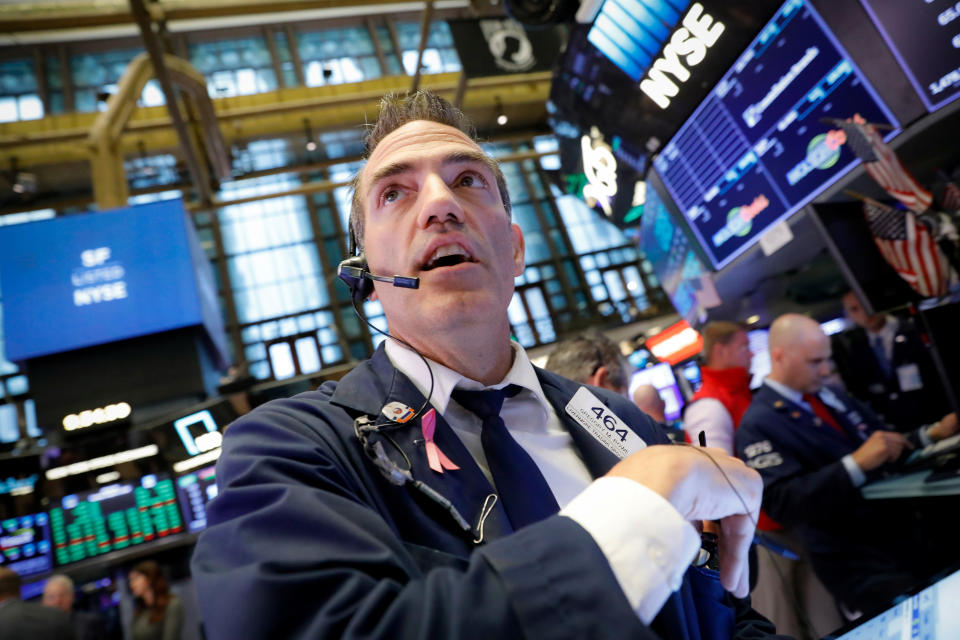Stock market news: August 7, 2019
The S&P 500 and Nasdaq ended narrowly higher Wednesday, after languishing in the red for much of the session. Earlier in the day, a spate of international central banks cut interest rates, signaling a synchronous tilt toward easier monetary policy as officials sounded the alarms on the impact of ongoing trade tensions to global growth.
Haven assets including U.S. Treasurys and precious metal prices continued to gap higher following a rout in risk assets earlier this week. Gold prices breached the $1,500 per ounce level for the first time since 2013. German bond yields slid further into negative territory, with Germany’s yield curve flattening the most since the financial crisis Wednesday morning.
Here were the main moves in the market, as of the end of regular trading:
S&P 500 (^GSPC): +0.08%, or 2.25 points
Dow (^DJI): -0.08%, or 21.74 points
Nasdaq (^IXIC): +0.36%, or 29.56 points
10-year Treasury yield (^TNX): -2.8 bps to 1.711%
Gold futures (GC=F): +1.7% to $1,509.40 per ounce
U.S. dollar index (DX-Y.NYB): -0.05% to 97.58
U.S. dollar to onshore Chinese yuan rate ( CNY=X): -0.0256% to 7.0222
At the lows of the day, the Dow was off as many as 589 points.
New Zealand’s central bank lowered its benchmark interest rate by 50 basis points, a more aggressive cut than had been expected by most economists, to an all-time low of 1%. The country’s Reserve Bank Governor Adrian Orr signaled that economic headwinds had risen, and that further action – including cutting to negative interest rates – could be warranted.
Other economies also saw their key interest rates lowered Wednesday, on account of rising global uncertainties. Thailand’s central bank unexpectedly cut rates by 25 basis points, while India’s central bank decreased its own rate by 35 basis points.
The contemporaneous moves on the part of the three central banks underscored a global economy troubled by mounting trade tensions and slowing growth, with central bankers rushing in to provide support.
President Donald Trump weighed in on the slew of rate cuts Wednesday morning, reiterating his call for the Federal Reserve to do the same.
“‘Three more Central Banks cut rates.’ Our problem is not China – We are stronger than ever, money is pouring into the U.S. while China is losing companies by the thousands to other countries, and their currency is under siege – Our problem is a Federal Reserve that is too..... ....proud to admit their mistake of acting too fast and tightening too much (and that I was right!). They must Cut Rates bigger and faster, and stop their ridiculous quantitative tightening NOW,” Trump wrote in a series of Twitter posts.
“Three more Central Banks cut rates.” Our problem is not China - We are stronger than ever, money is pouring into the U.S. while China is losing companies by the thousands to other countries, and their currency is under siege - Our problem is a Federal Reserve that is too.....
— Donald J. Trump (@realDonaldTrump) August 7, 2019
....terrible thing to watch, especially when things could be taken care of sooo easily. We will WIN anyway, but it would be much easier if the Fed understood, which they don’t, that we are competing against other countries, all of whom want to do well at our expense!
— Donald J. Trump (@realDonaldTrump) August 7, 2019
However, one of the more dovish members of the Federal Reserve suggested further easing in the U.S. may be overly preemptive at this point until the effects of the Fed’s 25 basis point cut last week could be assessed, St. Louis Fed President James Bullard said in a speech Tuesday.
“While additional policy action may be desirable, the long and variable lags in the effects of monetary policy suggest that the effects of previous actions are only now beginning to impact macroeconomic outcomes,” he said in prepared remarks.
And while recent developments in trade negotiations suggest it will be “difficult to reach a stable global trade regime over the forecast horizon,” Bullard added that “U.S. monetary policy cannot reasonably react to the day-to-day give-and-take of trade negotiations.” Bullard reiterated that he saw just one more rate cut in 2019.
Ahead of another meeting between U.S. and Chinese trade negotiators in September, market participants continue to eye the yuan against the U.S. dollar, after the U.S. Treasury designated China a currency manipulator Monday.

On Wednesday, the People’s Bank of China (PBOC) set its yuan fixing at 6.9996 per dollar, weaker than Tuesday’s fixing but stronger than the 7-per-dollar level the yuan initially breached Monday for the first time in more than a decade. However, the PBOC allows the yuan to move 2% in either direction from its midpoint fixing, meaning the currency could still weaken past 7-per-dollar and remain within range.
While stocks have largely moved more on trade-related headlines than on fundamentals this week, investors continue to monitor corporate earnings results for the direction of growth for major public companies. Tuesday after market close, Disney (DIS) missed consensus expectations on both the top and bottom lines, as mounting costs took a hit to results ahead of the launch of its streaming platform later this year. Disney also announced it would be releasing a bundle of Disney+, ESPN+ and Hulu for $12.99 per month, in its bid to compete with streaming incumbent Netflix (NFLX).
Companies including Lyft (LYFT) and Roku (ROKU) report after market close Wednesday.
—
Emily McCormick is a reporter for Yahoo Finance. Follow her on Twitter: @emily_mcck
Read more from Emily:
Economy adds 164,000 jobs in July, unemployment rate sits at 3.7%
Netflix’s 2Q global paid subscriber additions miss expectations
Tech companies like Lyft want your money – not ‘your opinion’
Follow Yahoo Finance on Twitter, Facebook, Instagram, Flipboard, LinkedIn, andreddit.
Read the latest financial and business news from Yahoo Finance

